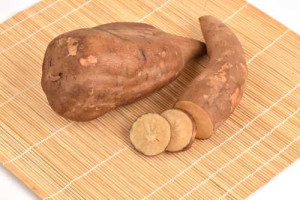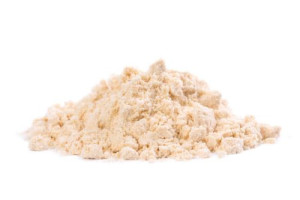Yacon
Table of Contents
NEWS: This superfood is now available in the SANEStore as a convenient whole-food powder so you can more easily enjoy it in smoothies and recipes.

Raw Yacon leaves contain a rich myriad of vitamins and minerals. In South America, tea from the yacon leaf has long been used as an herbal remedy for diabetes and high blood pressure. Research indicates that yacon leaves are effective at normalizing blood sugar levels. The yacon leaves oligofructose properties act similar to insulin in the body and reduces the burden on the pancreas. Studies also suggest that yacon leaves are beneficial for those with hypertension. By thinning the blood Yacon can lower blood pressure by 5 to 10 percent. It can also lower cholesterol and discourage clot formation. Yacon leaves also stimulate the body to break down fatty cells while boosting the metabolism. For this reason organic yacon leaf powder has gained increased popularity as a diet aid.
Yacon is a perennial herb native to the Andes Mountain Range in Central America at elevations of 900 to 3000 meters. Dating back to the period of the Incas, it has been cultivated extensively around the region for consumption and medicinal purposes. The wonderful benefits of yacon then discovered by ancient Peruvians and confirmed by modern science have gained increased popularity in Japan, Europe and now the US.
Why Try Yacon Superfood?
- Normalizing blood sugar levels
- Reducing blood pressure
- Reducing the risk of atherosclerosis
- Reducing the risk of osteoporosis
- Prebiotic & antioxidant properties
- Nourishing & protecting the liver
Health benefits of Yacon Root?
IUCN (International Union for the Conservation of Nature) defines Yacon as “a South American herb used to make a jelly or syrup, and chewed raw or cooked.” It has several natural health advantages including improving digestion, preventing digestive problems, lowering cholesterol, and promoting a healthy weight.
Yacon Root and Digestion:
Yacon root contains indigestible fructooligosaccharides (FOS), which help promote digestive health by encouraging the growth of friendly bacteria in the large intestine. This, among other things, helps reduce constipation and alleviate diarrhea.
Yacon root is also known to contain a chemical compound called Methyl sylvestre, which has been shown to prevent bloating and loss of gas after eating by interrupting the fermentation process that causes these symptoms.
Yacon Root and Cholesterol:
The FOS found in Yacon roots may also help lower LDL cholesterol levels.
Yacon Root and Weight Loss:
Yacon is also touted as a weight loss aid, with some saying it diminishes appetite and cravings for unhealthy food. Although there are no scientific studies to support this claim, there are several reports of its use that have shown approximately 2 pounds of weight loss per week when used in conjunction with dieting and exercise.
Since yacon root has the ability to build up friendly bacteria in the digestive system, it also helps promote better absorption of nutrients from food.
This makes it easier for your body to extract all the nutrition possible from each meal, making it more effective at nourishing your cells instead of storing excess energy. For this reason, many people report feeling less hungry after taking Yacon Root supplements even though they eat less food overall.
Yacon Root Health benefits:
Yacon root has also been found to help boost energy levels, in addition to a slew of other health advantages. Because it includes antioxidants that assist dangerous free radicals produced during cell energy production, it may improve energy levels.
It works in tandem with vitamin A to promote improved immunity function while promoting healthy skin and hair by working synergistically with vitamin A
Yacon Roots Side effects:
So far, no side effects have been reported when taken as directed. However, even though they are natural some people may be allergic or sensitive to certain parts of yacon plants that cause adverse reactions like :
Vomiting, stomach pain, rashes, weakness, numbness in the lips and tongue, swelling of the eyes or face; wheezing; tightness of the throat; and trouble breathing.
Yacon Root Dosage:
Take 200mg (2 capsules) 1-2 times daily as a dietary supplement. Alternatively, combine 2 teaspoons of powdered Yacon roots in 200ml water and drink on an empty stomach 30 minutes before your morning meal.
References
1. G. Butler G, D. Rivera (2004). “Innovations in Peeling Technology for Yacon”. Project Report. (International Potato Center).
2. S. Graefe, M. Hermann, I. Manrique, S. Golombek & A. Buerkert (2004). “Effects of post-harvest treatments on the carbohydrate composition of yacon roots in the Peruvian Andes” (PDF). Field Crops Research 86 (2–3): 156–165. doi:10.1016/j.fcr.2003.08.003.
3. Grau, J. Rea (1997). “Yacon. Smallanthus sonchifolius”. In M. Hermann and J. Heller (eds). Andean roots and tubers: Ahipa, arracacha, maca, yacon. Promoting the conservation and use of underutilized and neglected crops 21. Institute of Plant Genetics and Crop Plant Research, Gatersleben/International Plant Genetic Resources Institute, Rome, Italy. pp. 199–242.
4. M. Hermann M, I. Freire & C. Pazos (1999). “Compositional diversity of the yacon storage root”. Impact on a changing world, Program Report 1997-1998. International Potato Center. pp. 425–432.
5. Manrique, M. Hermann, T. Bernet (2004). Yacon – Fact Sheet (PDF). International Potato Center. ISBN 92-9060-244-9.
6. Manrique & M. Hermann (2004). “El potencial del yacón en la salud y la nutrición”. XI Congreso Internacional de Cultivos Andinos, Cochabamba, Bolivia.
7. Manrique, A. Párraga & M. Hermann (2005). “Yacon syrup: Principles and processing”. Series: Conservación y uso de la biodiversidad de raíces y tubérculos andinos: Una década de investigación para el desarrollo (1993-2003) (International Potato Center, Universidad Nacional Daniel Alcides Carrión, Erbacher Foundation, Swiss Agency for Development and Cooperation).
8. D. Rivera & I. Manrique (2005). Zumo de Yacón – Ficha Técnica. International Potato Center. ISBN 92-9060-251-1.
9. Seminario, M. Valderrama & I. Manrique (2003). El yacón: fundamentos para el aprovechamiento de un recurso promisorio. International Potato Center, Universidad Nacional de Cajamarca, Swiss Agency for Development and Cooperation, Lima, Perú. 60 p.
10. Phytologia; Designed to Expedite Botanical Publication. New York 39:51. 1978
11. USDA, ARS, GERMPLASM RESOURCES INFORMATION NETWORK. Smallanthus sonchifolius in the Germplasm Resources Information Network (GRIN), US Department of Agriculture Agricultural Research Service. Accessed on 07-Oct-06.
12. “Drugs for Neglected Diseases Initiative (DNDi),” http://www.dndi.org/.
13. A. Urbina, “Specific chemotherapy of Chagas disease: relevance, current limitations and new approaches,” Acta Tropica, vol. 115, no. 1-2, pp. 55–68, 2010.
14. Janecka, A. Wyrebska, K. Gach, J. Fichna, and T. Janecki, “Natural and synthetic α-methylenelactones and α-methylenelactams with anticancer potential,” Drug Discovery Today, vol. 17, no. 11-12, pp. 561–572, 2012.
15. J.-R. Ioset, “Natural products for neglected diseases: a review,” Current Organic Chemistry, vol. 12, no. 8, pp. 643–666, 2008.
16. E. Izumi, T. Ueda-Nakamura, V. F. Veiga Júnior, and C. V. Nakamura, “Natural products and Chagas’ disease: a review of plant compounds studied for activity against Trypanosoma cruzi,” Natural Product Reports, vol. 28, no. 4, pp. 809–823, 2011.
17. T. J. Schmidt, S. A. Khalid, A. J. Romanha, et al., “The potential of secondary metabolites from plants as drugs or leads against protozoan neglected diseases—part I,” Current Medicinal Chemistry, vol. 19, no. 4, pp. 2128–2175, 2012.
18. T. J. Schmidt, S. A. Khalid, A. J. Romanha, et al., “The potential of secondary metabolites from plants as drugs or leads against protozoan neglected diseases—part II,” Current Medicinal Chemistry, vol. 19, no. 4, pp. 2176–2228, 2012.
19. G. Tempone, P. Sartorelli, C. Mady, and F. Fernandes, “Natural products to anti-trypanosomal drugs: an overview of new drug prototypes for American trypanosomiasis,” Cardiovascular and Hematological Agents in Medicinal Chemistry, vol. 5, no. 3, pp. 222–235, 2007.
20. W. Wright, “Recent developments in research on terrestrial plants used for the treatment of malaria,” Natural Product Reports, vol. 27, no. 7, pp. 961–968, 2010.
21. Ojansivu, C. L. Ferreira, and S. Salminen, “Yacon, a new source of prebiotic oligosaccharides with a history of safe use,” Trends in Food Science & Technology, vol. 22, no. 1, pp. 40–46, 2011.
22. Grau and J. Rea, Andean Roots and Tubers, International Plant Genetic Resources Institute (IPGRI), Rome, Italy, 1997.
23. S. B. Genta, W. M. Cabrera, M. I. Mercado, A. Grau, C. A. Catalán, and S. S. Sánchez, “Hypoglycemic activity of leaf organic extracts from Smallanthus sonchifolius: constituents of the most active fractions,” Chemico-Biological Interactions, vol. 185, no. 2, pp. 143–152, 2010.
24. Inoue, S. Tamogami, H. Kato et al., “Antifungal melampolides from leaf extracts of Smallanthus sonchifolius,” Phytochemistry, vol. 39, no. 4, pp. 845–848, 1995.
25. F. Lin, M. Hasegawa, and O. Kodama, “Purification and identification of antimicrobial sesquiterpene lactones from yacon (Smallanthus sonchifolius) leaves,” Bioscience, Biotechnology and Biochemistry, vol. 67, no. 10, pp. 2154–2159, 2003.
26. I. Mercado, M. V. Coll Aráoz, A. Grau, and C. A. N. Catalán, “New acyclic diterpenic acids from yacon (Smallanthus sonchifolius) leaves,” Natural Product Communications, vol. 5, no. 11, pp. 1721–1726, 2010.
27. S. S. Hong, S. A. Lee, X. H. Han et al., “Melampolides from the leaves of Smallanthus sonchifolius and their inhibitory activity of LPS-induced nitric oxide production,” Chemical & Pharmaceutical Bulletin, vol. 56, no. 2, pp. 199–202, 2008.
28. V. P. Sülsen, F. M. Frank, S. I. Cazorla et al., “Trypanocidal and leishmanicidal activities of sesquiterpene lactones from Ambrosia tenuifolia Sprengel (Asteraceae),” Antimicrobial Agents and Chemotherapy, vol. 52, no. 7, pp. 2415–2419, 2008.
29. V. Sülsen, P. Barrera, L. Muschietti, V. Martino, and M. Sosa, “Antiproliferative effect and ultrastructural alterations induced by psilostachyin on Trypanosoma cruzi,” Molecules, vol. 15, no. 1, pp. 545–553, 2010.
30. V. P. Sülsen, F. M. Frank, S. I. Cazorla et al., “Psilostachyin C: a natural compound with trypanocidal activity,” International Journal of Antimicrobial Agents, vol. 37, no. 6, pp. 536–543, 2011.
31. S. Joshi, V. N. Kamat, and H. Fuhrer, “Revised structure of enhydrin,” Tetrahedron Letters, vol. 12, no. 26, pp. 2373–2376, 1971.
32. W. Herz and S. V. Bhat, “Isolation and structure of two new germacranolides from Polymnia uvedalia (L.) L,” Journal of Organic Chemistry, vol. 35, no. 8, pp. 2605–2611, 1970.
33. Le Van and N. H. Fischer, “Three new melampolide sesquiterpenes, polymatin A, B and C, from Polymnia maculata Cav. var. maculata,” Phytochemistry, vol. 18, no. 5, pp. 851–854, 1979.
34. Buckingham, A. M. Hodgson, and S. P. Walford, Eds., The Dictionary of Natural Products on CDROM, Chapman & Hall/CRC, Boca Raton, Fla, USA, 2002.
35. Chaturvedi, “Sesquiterpene lactones: structural diversity and their biological activities,” in Opportunity, Challenge and Scope of Natural Products in Medicinal Chemistry, pp. 313–334, Research Signpost, Kerala, India, 2011.
36. T. J. Schmidt, “Structure-activity relationships of sesquiterpene lactones,” in Studies in Natural Products Chemistry, Atta-ur-Rahman, Ed., vol. 33, pp. 309–392, Elsevier Science, Amsterdam, The Netherlands, 2006.
37. M. C. Canavaci, J. M. Bustamante, A. M. Padilla et al., “In vitro and in vivo high-throughput assays for the testing of anti-Trypanosoma cruzi compounds,” PLoS Neglected Tropical Diseases, vol. 4, no. 7, article e740, 2010.
38. Siriwan, T. Naruse, and H. Tamura, “Effect of epoxides and α-methylene-γ-lactone skeleton of sesquiterpenes from yacon (Smallanthus sonchifolius) leaves on caspase-dependent apoptosis and NF-κB inhibition in human cercival cancer cells,” Fitoterapia, vol. 82, no. 7, pp. 1093–1101, 2011.
39. G. Choi, O. H. Kang, Y. S. Lee et al., “Antimicrobial activity of the constituents of Smallanthus sonchifolius leaves against methicillin-resistant Staphylococcus aureus,” European Review for Medical and Pharmacological Sciences, vol. 14, no. 12, pp. 1005–1009, 2010.
40. W. Feltenstein, W. Schühly, J. E. Warnick, N. H. Fischer, and K. J. Sufka, “Anti-inflammatory and anti-hyperalgesic effects of sesquiterpene lactones from Magnolia and Bear’s foot,” Pharmacology Biochemistry and Behavior, vol. 79, no. 2, pp. 299–302, 2004.








